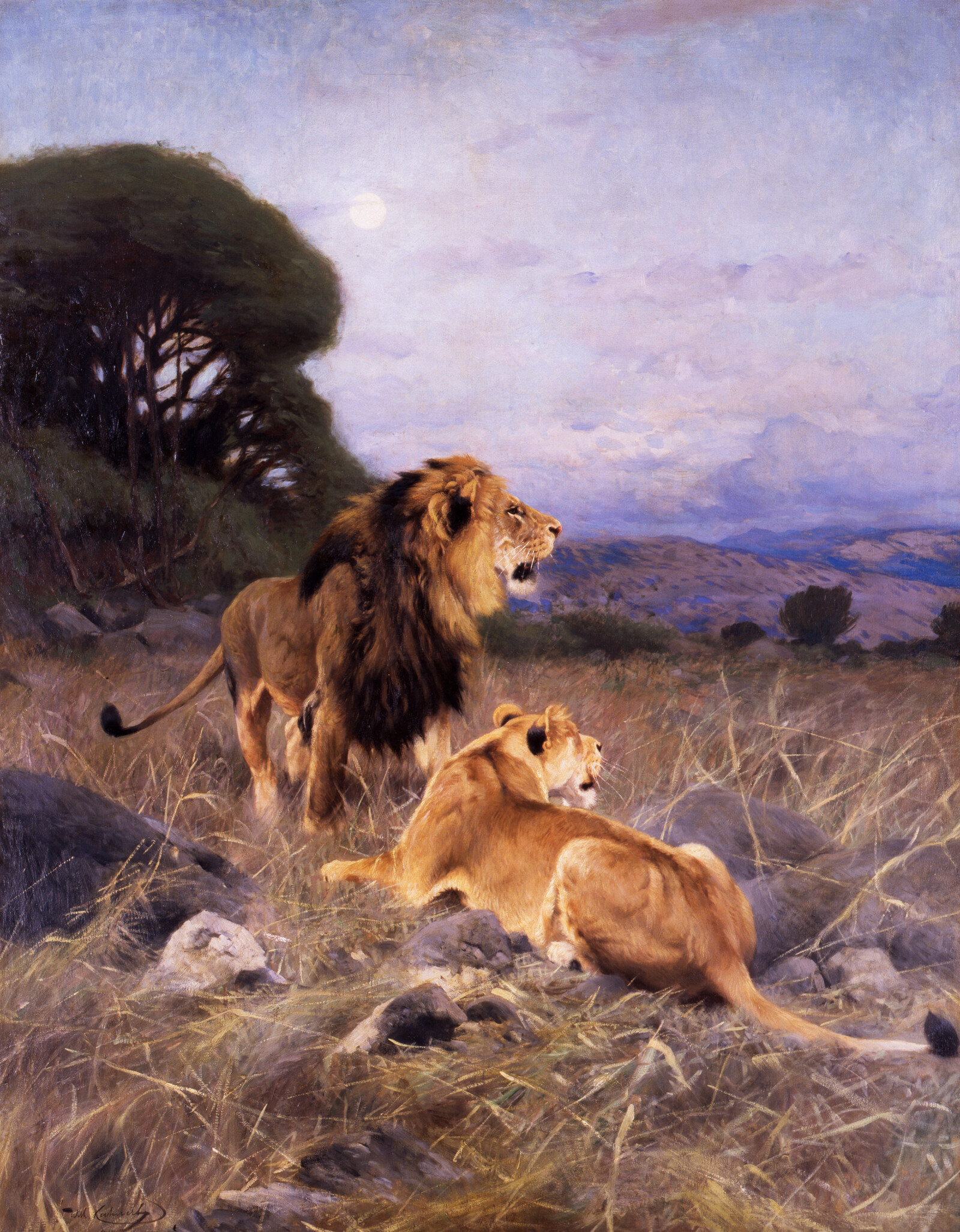October 25, 2018–January 27, 2019
Römerberg
60311 Frankfurt am Main
Germany
T +49 69 2998820
welcome@schirn.de
www.schirn-mag.com
Facebook / Twitter / YouTube / Instagram / Pinterest / #KingOfTheAnimals / #Schirn
Wilhelm Kuhnert (1865–1926) shaped the concept of Africa in Europe and in the United States more than any other painter of his time. In the late 19th and early 20th century, he was one of the first European artists to set out on a number of journeys to the colony of German East Africa, which at that time was still largely unexplored. The drawings and oil sketches of the flora and fauna in the region that he made during these trips served as references for monumental paintings that he later produced in his studio in Berlin. Kuhnert exhibited his works internationally with great success, consequently becoming the leading interpreter of African wildlife. The Schirn Kunsthalle Frankfurt is presenting the first major retrospective on the life and work of the artist with some 120 works. Besides studies and paintings from European and American museums, private collections, and Kuhnert’s estate, the exhibition unites a large number of the artist’s printed and commercial graphic works and publications. The presentation sheds light on Kuhnert’s oeuvre, not only against the background of the history of art and natural science but also that of German colonial history.
Dr. Philipp Demandt, Director of the Schirn Kunsthalle Frankfurt and curator of the exhibition comments: “Wilhelm Kuhnert is one of the outstanding painters and illustrators of his time. His pictures are not only a mirror and a medium of art and natural history, but also of colonial history. Hence the Schirn Kunsthalle Frankfurt’s decision to dedicate the very first retrospective to Wilhelm Kuhnert is not in spite of but in fact because of those ‘big blank spots’ that he sought out in faraway countries—and which continue to exist in our collective memory. The story we aim to tell will teach us a great deal about the mechanisms of art and society, politics and science, about remembering and forgetting—and at the same time about ourselves.”
Kuhnert was an animal and landscape painter who had trained at the Royal Academy of Fine Arts in Berlin. He developed an early interest in African wild animals, whose appearance and behavior he had previously only been able to study up close at the Berlin Zoo. Zoological gardens began originating in the mid-19th century. They reflected increased knowledge and scientific progress, a curiosity about the world, and the imperialist aspirations of the bourgeois era. At the same time, the market for animal paintings and sculptures was expanding in the late 19th century with the young, ambitious generation of artists entering this field of activity. In addition to formalist aspects and the appeal of the new, however, these artworks also matched the spirit of the times: pictures of lions, tigers, and elephants in particular were seen as symbols of strength, dominance, and superiority and conveyed the spirit of a society that was aiming for its power-political “place in the sun.” The notion of animals became a lenticular image of human beings: on the one hand, animals were models for the natural—and hence the divine, social, and political—order; and on the other they represented the ideal of unconscious, unfettered freedom, the very opposite of bourgeois existence. African wild animals provided an unrestricted space of association for German Nature Romanticism and exoticism.
Wilhelm Kuhnert’s oeuvre heralds aspects of the modern age: painting en plein air, the experimental pencil drawing, exoticism, the determination to explore distant lands, and travel as a means of expanding one’s perspective and experience, often linked with escapism and a critical attitude toward civilization. In his painting Kuhnert pursued an almost scientific approach and recorded the characteristics of the animals as accurately as possible. Although he was neither a biologist nor a zoologist, his detailed artistic and written studies point to an interest in African wildlife that went well beyond purely painterly issues. His animal pictures were disseminated in zoological books such as Brehms Tierleben (Brehm’s Life of the Animals) and in publications by the director of the Frankfurt Zoo, Wilhelm Haacke, as well as in the form of classroom wall charts. They were even reproduced on the wrappers of Stollwerck chocolate. Although Wilhelm Kuhnert remains one of the most widely collected artists to this day, his oeuvre is still virtually unknown to the public at large.
The exhibition King of the Animals. Wilhelm Kuhnert and the Image of Africa is supported by the Gemeinnütziger Kulturfonds Frankfurt RheinMain.
A comprehensive catalog with a foreword by Philipp Demandt and contributions by Felicitas Becker, Kathleen Chapman, Philipp Demandt, Alexander Gall, Bernhard Gissibl, Miriam Oesterreich, and Ilka Voermann has been published by Hirmer Verlag.
On October 25 at 7pm, the Schirn will be presenting a panel discussion under the title The Shaping of an Image: How present is Kuhnert’s portrayal of Africa today?. Experts will be discussing the topicality of the image of Africa that Wilhelm Kuhnert helped to create. Participating in the discussion will be historian Felicitas Becker (Ghent University), Philipp Demandt (curator of the exhibition and director of the Schirn Kunsthalle Frankfurt), Dagmar Mundhenke (deputy editor of africa positive), Nadine Siegert (deputy director of the Iwalewahaus, Bayreuth) and anthropologist, journalist and filmmaker Vanessa Wijngaarden (University of Johannesburg). Moderation: Bianca Schwarz (hr2). In German language.
Director: Dr. Philipp Demandt
Curators: Dr. Philipp Demandt and Dr. Ilka Voermann
Press contact: Pamela Rohde (Head of Press/Public Relations):
presse [at] schirn.de / T (+49 69) 29 98 82 148
Press material: www.schirn.de/en/ (texts, images, and films for download under PRESS)



